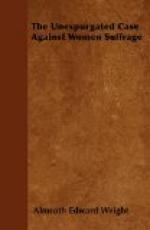Coming back from the particular to the general, and from the logical to the moral aspect of woman’s claim to control the finances of the State on the ground that she is a tax-payer, it will suffice to point out that this claim is on a par with the claim to increased political power and completer control over the finances of the State which is put forward by a class of male voters who are already paying much less than their pro rata share of the upkeep of the State.
In each case it is a question of trying to get control of other people’s money. And in the case of woman it is of “trying on” in connexion with her public partnership with man that principle of domestic partnership, “All yours is mine, and all mine’s my own.”
Next to the plea of justice, the plea which is advanced most insistently by the woman who is contending for a vote is the plea of liberty.
We have here, again, a word which is a valuable asset to woman suffrage both in the respect that it brings moral pressure to bear, and in the respect that it is a word of ambiguous meaning.
In accordance with this we have John Stuart Mill making propaganda for woman suffrage in a tractate entitled the_ Subjection of_ Women; we have a Woman’s Freedom League—“freedom” being a question-begging synonym for “parliamentary franchise”—and everywhere in the literature of woman’s suffrage we have talk of woman’s “emancipation”; and we have women characterised as serfs, or slaves—the terms serfs and slaves supplying, of course, effective rhetorical synonyms for non-voters.
When we have succeeded in getting through these thick husks of untruth we find that the idea of liberty which floats before the eyes of woman is, not at all a question of freedom from unequitable legal restraints, but essentially a question of getting more of the personal liberty (or command of other people’s services), which the possession of money confers and more freedom from sexual restraints.
The suffragist agitator makes profit out of this ambiguity. In addressing the woman worker who does not, at the rate which her labour commands on the market, earn enough to give her any reasonable measure of financial freedom, the agitator will assure her that the suffrage would bring her more money, describing the woman suffrage cause to her as the cause of liberty. By juggling in this way with the two meanings of “liberty” she will draw her into her toils.
The vote, however, would not raise wages of the woman worker and bring to her the financial, nor yet the physiological freedom she is seeking.
The tactics of the suffragist agitator are the same when she is dealing with a woman who is living at the charges of a husband or relative, and who recoils against the idea that she lies under a moral obligation to make to the man who works for her support some return of gratitude. The suffragist agitator will point out to her that such an obligation is slavery, and that the woman’s suffrage cause is the cause of freedom.




